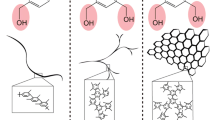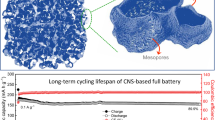Abstract
By virtue of its long lifespan and outstanding storage intensity with near-zero heat loss, salt hydrate thermochemical energy storage (TES) materials provide a feasible option for the effective use of renewable energy and overcoming its unsynchronized supply and demand. Here, an activated porous carbon originating from the zeolite imidazolate framework (ZHCM) is fabricated and served as the carbon matrix for the LiOH TES material. The as-synthesized Li/ZHCM2-40 not only has excellent storage intensity (maximum 2414.2 kJ·kg−1) with low charging temperature, but also shows great hydration properties stemming from the ultrahigh surface area and hierarchical porous structure of ZHCM2. Besides, this composite material exhibits superior thermal conductivity, while its storage intensity is only attenuated by 10.2% after 15 times of consecutive charge—discharge process, revealing its outstanding cycle stability. And the numerical simulation results also demonstrate its superior heat transfer performance. The developed LiOH TES composite may afford a new avenue for efficient low-grade thermochemical energy storage and liberate the possibility of further exploration of metal organic frameworks derived porous carbon matrix in the future.

Similar content being viewed by others
References
Carrillo, A. J.; González-Aguilar, J.; Romero, M.; Coronado, J. M. Solar energy on demand: A review on high temperature thermochemical heat storage systems and materials. Chem. Rev. 2019, 119, 4777–1816.
Li, Y. T.; Li, M. T.; Xu, Z. B.; Meng, Z. H.; Wu, Q. P. Dehydration kinetics and thermodynamics of ZrO(NO3)2-doped Ca(OH)2 for chemical heat storage. Chem. Eng. J. 2020, 399, 125841.
Koohi-Fayegh, S.; Rosen, M. A. A review of energy storage types, applications and recent developments. J. Energy Storage 2020, 27, 101047.
Yu, Z. P.; Feng, D. L.; Feng, Y. H.; Zhang, X. X. Thermal conductivity and energy storage capacity enhancement and bottleneck of shape-stabilized phase change composites with graphene foam and carbon nanotubes. Compos. A Appl. Sci. Manuf. 2022, 152, 106703.
Biesuz, M.; Valentini, F.; Bortolotti, M.; Zambotti, A.; Cestari, F.; Bruni, A.; Sglavo, V. M.; Sorarù, G. D.; Dorigato, A.; Pegoretti, A. Biogenic architectures for green, cheap, and efficient thermal energy storage and management. Renew. Energy 2021, 178, 96–107.
Cabeza, L. F.; De Gracia, A.; Zsembinszki, G.; Borri, E. Perspectives on thermal energy storage research. Energy 2021, 231, 120943.
Qi, G. Q.; Yang, J.; Bao, R. Y.; Xia, D. Y.; Cao, M.; Yang, W.; Yang, M. B.; Wei, D. C. Hierarchical graphene foam-based phase change materials with enhanced thermal conductivity and shape stability for efficient solar-to-thermal energy conversion and storage. Nano Res. 2017, 10, 802–813.
Li, A. J.; Xu, W. Z.; Chen, R.; Liu, Y. C.; Li, W. Fabrication of zeolitic imidazolate frameworks on layered double hydroxide nanosheets to improve the fire safety of epoxy resin. Compos. A Appl. Sci. Manuf. 2018, 112, 558–571.
Peng, J. J.; Tao, J.; Liu, Z. J.; Yang, Y. H.; Yu, L.; Zhang, M.; Wang, F.; Ding, Y. Ultra-stable and high capacity flexible lithiumion batteries based on bimetallic MOFs derivatives aiming for wearable electronic devices. Chem. Eng. J. 2021, 417, 129200.
Gulbalkan, H. C.; Haslak, Z. P.; Altintas, C.; Uzun, A.; Keskin, S. Assessing CH4/N2 separation potential of MOFs, COFs, IL/MOF, MOF/Polymer, and COF/Polymer composites. Chem. Eng. J. 2022, 428, 131239.
Gordeeva, L. G.; Tu, Y. D.; Pan, Q. W.; Palash, M. L.; Saha, B. B.; Aristov, Y. I.; Wang, R. Z. Metal-organic frameworks for energy conversion and water harvesting: A bridge between thermal engineering and material science. Nano Energy 2021, 84, 105946.
Chen, Y. Z.; Zhang, R.; Jiao, L.; Jiang, H. L. Metal-organic framework-derived porous materials for catalysis. Coord. Chem. Rev. 2018, 362, 1–23.
Wang, J.; Wang, Y. L.; Hu, H. B.; Yang, Q. P.; Cai, J. J. From metal-organic frameworks to porous carbon materials: Recent progress and prospects from energy and environmental perspectives. Nanoscale 2020, 12, 4238–4268.
DeCoste, J. B.; Peterson, G. W. Metal-organic frameworks for air purification of toxic chemicals. Chem. Rev. 2014, 114, 5695–5727.
Zhu, L. N.; Meng, L. J.; Shi, J. Q.; Li, J. H.; Zhang, X. S.; Feng, M. B. Metal-organic frameworks/carbon-based materials for environmental remediation: A state-of-the-art mini-review. J. Environ. Manag. 2019, 232, 964–977.
Chung, D. Y.; Lee, K. J.; Yu, S. H.; Kim, M.; Lee, S. Y.; Kim, O. H.; Park, H. J.; Sung, Y. E. Alveoli-inspired facile transport structure of N-doped porous carbon for electrochemical energy applications. Adv. Energy Mater. 2015, 5, 1401309.
Bai, F. H.; Xia, Y. D.; Chen, B. L.; Su, H. Q.; Zhu, Y. Q. Preparation and carbon dioxide uptake capacity of N-doped porous carbon materials derived from direct carbonization of zeolitic imidazolate framework. Carbon 2014, 79, 213–226.
Zhang, Y. N.; Dong, H. H.; Wang, R. Z.; Feng, P. H. Air humidity assisted sorption thermal battery governed by reaction wave model. Energy Stor. Mater. 2020, 27, 9–16.
Li, W.; Klemeš, J. J.; Wang, Q. W.; Zeng, M. Salt hydrate-based gas—solid thermochemical energy storage: Current progress, challenges, and perspectives. Renew. Sust. Energy Rev. 2022, 154, 111846.
Jiang, F.; Ge, Z. W.; Ling, X.; Cang, D. Q.; Zhang, L. L.; Ding, Y. L. Improved thermophysical properties of shape-stabilized NaNO3 using a modified diatomite-based porous ceramic for solar thermal energy storage. Renew. Energy 2021, 179, 327–338.
Donkers, P. A. J.; Sögütoglu, L. C.; Huinink, H. P.; Fischer, H. R.; Adan, O. C. G. A review of salt hydrates for seasonal heat storage in domestic applications. Appl. Energy 2017, 199, 45–68.
Alva, G.; Lin, Y. X.; Fang, G. Y. An overview of thermal energy storage systems. Energy 2018, 144, 341–378.
Zhang, Y. N.; Wang, R. Z.; Li, T. X. Thermochemical characterizations of high-stable activated alumina/LiCl composites with multistage sorption process for thermal storage. Energy 2018, 156, 240–249.
Zhao, Y. J.; Wang, R. Z.; Zhang, Y. N.; Yu, N. Development of SrBr2 composite sorbents for a sorption thermal energy storage system to store low-temperature heat. Energy 2016, 115, 129–139.
Solé, A.; Martorell, I.; Cabeza, L. F. State of the art on gas-solid thermochemical energy storage systems and reactors for building applications. Renew. Sust. Energy Rev. 2015, 47, 386–398.
Yan, T.; Wang, R. Z.; Li, T. X.; Wang, L. W.; Fred, I. T. A review of promising candidate reactions for chemical heat storage. Renew. Sust. Energy Rev. 2015, 43, 13–31.
Kubota, M.; Matsumoto, S.; Matsuda, H.; Huang, H. Y.; He, Z. H.; Yang, X. X. Chemical heat storage with LiOH/LiOH·H2O reaction for low-temperature heat below 373 K. Adv. Mater. Res. 2014, 953–954, 757–760.
Kubota, M.; Matsumoto, S.; Matsuda, H. Enhancement of hydration rate of LiOH by combining with mesoporous carbon for low-temperature chemical heat storage. Appl. Therm. Eng. 2019, 150, 858–863.
Li, W.; Klemeš, J. J.; Wang, Q. W.; Zeng, M. Development and characteristics analysis of salt-hydrate based composite sorbent for low-grade thermochemical energy storage. Renew. Energy 2020, 157, 920–940.
Li, W.; Klemeš, J. J.; Wang, Q. W.; Zeng, M. Characterisation and sorption behaviour of LiOH-LiCl@EG composite sorbents for thermochemical energy storage with controllable thermal upgradeability. Chem. Eng. J. 2021, 421, 129586.
Wang, R. T.; Jin, D. D.; Zhang, Y. B.; Wang, S. J.; Lang, J. W.; Yan, X. B.; Zhang, L. Engineering metal organic framework derived 3D nanostructures for high performance hybrid supercapacitors. J. Mater. Chem. A 2017, 5, 292–302.
Qie, L.; Chen, W. M.; Xu, H. H.; Xiong, X. Q.; Jiang, Y.; Zou, F.; Hu, X. L.; Xin, Y.; Zhang, Z. L.; Huang, Y. H. Synthesis of functionalized 3D hierarchical porous carbon for high-performance supercapacitors. Energy Environ. Sci. 2013, 6, 2497–2504.
Zheng, X. Y.; Lv, W.; Tao, Y.; Shao, J. J.; Zhang, C.; Liu, D. H.; Luo, J. Y.; Wang, D. W.; Yang, Q. H. Oriented and interlinked porous carbon nanosheets with an extraordinary capacitive performance. Chem. Mater. 2014, 26, 6896–6903.
Zhong, H. X.; Wang, J.; Zhang, Y. W.; Xu, W. L.; Xing, W.; Xu, D.; Zhang, Y. F.; Zhang, X. B. ZIF-8 derived graphene-based nitrogen-doped porous carbon sheets as highly efficient and durable oxygen reduction electrocatalysts. Angew. Chem., Int. Ed. 2014, 53, 14235–14239.
Deng, X. Y.; Li, J. J.; Zhu, S.; Ma, L. Y.; Zhao, N. Q. Boosting the capacitive storage performance of MOF-derived carbon frameworks via structural modulation for supercapacitors. Energy Stor. Mater. 2019, 23, 491–498.
Li, Y. G.; Zhou, W.; Wang, H. L.; Xie, L. M.; Liang, Y. Y.; Wei, F.; Idrobo, J. C.; Pennycook, S. J.; Dai, H. J. An oxygen reduction electrocatalyst based on carbon nanotube-graphene complexes. Nat. Nanotechnol. 2012, 7, 394–400.
Sevilla, M.; Mokaya, R. Energy storage applications of activated carbons: Supercapacitors and hydrogen storage. Energy Environ. Sci. 2014, 7, 1250–1280.
Li, Z.; Xu, Z. W.; Tan, X. H.; Wang, H. L.; Holt, C. M. B.; Stephenson, T.; Olsen, B. C.; Mitlin, D. Mesoporous nitrogen-rich carbons derived from protein for ultra-high capacity battery anodes and supercapacitors. Energy Environ. Sci. 2013, 6, 871–878.
Feng, L. X.; Wang, K.; Zhang, X.; Sun, X. Z.; Li, C.; Ge, X. B.; Ma, Y. W. Flexible solid-state supercapacitors with enhanced performance from hierarchically graphene nanocomposite electrodes and ionic liquid incorporated gel polymer electrolyte. Adv. Funct. Mater. 2018, 28, 1704463.
Shen, J. M.; Li, Y.; Wang, C. H.; Luo, R.; Li, J. S.; Sun, X. Y.; Shen, J. Y.; Han, W. Q.; Wang, L. J. Hollow ZIFs-derived nanoporous carbon for efficient capacitive deionization. Electrochim. Acta 2018, 273, 34–42.
Clark, R. J.; Mehrabadi, A.; Farid, M. State of the art on salt hydrate thermochemical energy storage systems for use in building applications. J. Energy Stor. 2020, 27, 101145.
Li, S. J.; Huang, H. Y.; Li, J.; Kobayashi, N.; Osaka, Y.; He, Z. H.; Yuan, H. R. The effect of 3D carbon nanoadditives on lithium hydroxide monohydrate based composite materials for highly efficient low temperature thermochemical heat storage. RSC Adv. 2018, 8, 8199–8208.
Wang, Q.; Xie, Y. Y.; Ding, B.; Yu, G. L.; Ye, F.; Xu, C. Structure and hydration state characterizations of MgSO4-zeolite 13x composite materials for long-term thermochemical heat storage. Sol Energy Mater. Sol. Cells 2019, 200, 110047.
Li, S. J.; Huang, H. Y.; Yang, X. X.; Bai, Y.; Li, J.; Kobayashi, N.; Kubota, M. Hydrophilic substance assisted low temperature LiOH·H2O based composite thermochemical materials for thermal energy storage. Appl. Therm. Eng. 2018, 128, 706–711.
Acknowledgements
The authors appreciate the support from the Key-Area Research and Development Program of Guangdong Province (No. 2020B0202010004), the National Natural Science Foundation of China (No. 52071192), and the Key Research Program of Frontier Sciences, Chinese Academy of Sciences (CAS) (No. QYZDY-SSW-JSC038).
Author information
Authors and Affiliations
Corresponding authors
Electronic Supplementary Material
12274_2022_4415_MOESM1_ESM.pdf
Fabrication of LiOH-metal organic framework derived hierarchical porous host carbon matrix composites for seasonal thermochemical energy storage
Rights and permissions
About this article
Cite this article
Yang, X., Li, S., Zhao, J. et al. Fabrication of LiOH-metal organic framework derived hierarchical porous host carbon matrix composites for seasonal thermochemical energy storage. Nano Res. 15, 8028–8038 (2022). https://doi.org/10.1007/s12274-022-4415-2
Received:
Revised:
Accepted:
Published:
Issue Date:
DOI: https://doi.org/10.1007/s12274-022-4415-2




